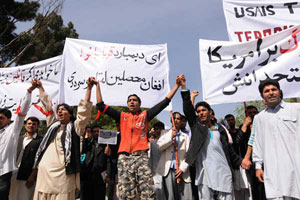(lead article)
Afghans protest war,
bombings of villages
U.S. warplanes kill more than 100 civilians

|
|
AFP/Getty Images/Massoud Hossaini
|
|
Some 1,000 University of Kabul students march in Afghan capital May 10 following recent U.S. air strikes in Afghanistan, which killed more than 100 civilians. Signs in Dari denounce “America and its allies,” protest the bombing raid, and call for “murderers to be tried.”
|
BY CINDY JAQUITH
Upwards of 1,000 university students in Kabul, the capital of Afghanistan, marched May 10 to protest U.S. missile strikes in two villages that killed more than 100 people, most of them civilians. Carrying a banner that said “USA is the biggest terrorist around the world,” the students called for the prosecution of the U.S. troops responsible.
The Afghan news Web site Quqnoos, based in Kabul, reported that student leaders read out a statement that said, “Our people are fed up with Taliban beheadings and suicide bombings. On the other hand, the massacre of civilians by the American forces is a crime that our people will never forget.”
Referring to U.S. officials’ claim to regret the civilian deaths, the statement said, “You cannot wash away the blood of Bala Buluk martyrs with bizarre words of excuse and sorrow.”
The missile strikes occurred in the Bala Buluk district of Farah Province in western Afghanistan May 4. Hundreds in the province took to the streets May 7 in angry protests. Haji Nangyalai told the Pakistani daily Dawn the marchers wanted to “show our anger at the crimes committed by the American forces. They have killed our innocent people carelessly.” Police fired on the demonstrators, wounding three.
Shopkeepers in Farah, the main city of Farah Province, closed shops, saying they would not reopen until an investigation is carried out to their satisfaction.
Pentagon officials have refused to accept responsibility for the carnage and blamed the Taliban for the civilian deaths. One U.S. statement said the reports were “extremely over-exaggerated.”
A joint U.S.-Afghan team “investigating” the incident released its findings May 9. The team claimed that Taliban fighters forced villagers into houses and then fired on Afghan army and coalition units from those houses, using the civilians “as human shields.”
The report also argued it was impossible to tell how many of the dead were civilians because they had all been buried.
Two Afghans interviewed by the New York Times gave descriptions of what they saw that day, sharply contradicting Washington’s version. The two, who are residents of the Shiwan and Granai villages, said the Taliban had engaged Afghan forces and then retreated to the villages, later withdrawing from the area. Bombs were dropped on both villages after the Taliban had left, they said.
Abdul Basir Khan, a member of the province council, said he had collected reports of 147 civilians killed in the raid. If that figure is confirmed it would be the highest number of civilians killed in a single attack since the war began in 2001, according to Time magazine.
Abdul Rauf Ahmadi, a police spokesperson for western Afghanistan, said based on reports from local police, the Red Cross, and residents, more than 100 people were killed. “Twenty-five to 30 of them are Taliban,” he said, “and the rest are civilians, including children, women, and elderly people.”
This is not the first time Washington has denied responsibility for killing civilians in Afghanistan. In August 2008 the Afghan government and the United Nations reported that as many as 90 civilians had died in a U.S. missile strike in Herat Province. U.S. officials insisted almost all the dead were Islamist fighters. It was not until October 8, after aerial photos of the scene showing the victims were released, that Washington backed down and admitted to 33 civilian deaths in the attack.
The United Nations reports that the number of civilian deaths in the Afghan war leaped by 40 percent in the last year, to 2,118.
Despite criticism of its war, Washington is escalating it. The war budget submitted by the Pentagon for fiscal 2010 includes $65 billion for Afghanistan, compared to $61 billion for Iraq.
U.S. commander replaced
Defense Secretary Robert Gates announced May 11 that he has replaced Gen. David McKiernan, the U.S. commander in Afghanistan, with Lt. Gen. Stanley McChrystal, the officer credited with directing the teams that captured former Iraqi president Saddam Hussein and killed al-Qaeda leader Abu Musab al-Zarqawi.
“Defense officials said that General McKiernan was removed because of what they described as a conventional approach to what has become one of the most complicated military challenges in American history,” the New York Times said. McChrystal was head of the Pentagon’s Special Operations command from September 2003 to August 2008.
Lt. Gen. David Rodriguez, who headed the 82nd Airborne Division in Afghanistan previously, was named deputy commander. He is currently Gates’s military assistant.
In Afghanistan U.S. engineers and construction workers are working to complete a new U.S. base in Helmand Province, site of some of the sharpest battles with Islamist forces.
U.S. national security advisor Gen. James Jones brusquely dismissed Afghan president Hamid Karzai’s complaints about the civilian deaths from air strikes. The general stated May 10 that “certainly to tie the hands of our commanders and say we’re not going to conduct air strikes … would be imprudent.”
Related articles:
Toilers bear brunt of Pakistani offensive
U.S. troops to patrol cities in Iraq past ‘pullout deadline’
U.S. troops out of Afghanistan!
| 


